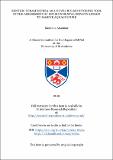Files in this item
Benthic foraminifera as a novel bio-monitoring tool in the assessment of environmental impacts linked to marine aquaculture
Item metadata
| dc.contributor.advisor | Austin, W. E. N. (William E. N.) | |
| dc.contributor.author | Alammar, Montaha | |
| dc.coverage.spatial | vii, v, 200 p. | en_US |
| dc.date.accessioned | 2019-11-20T14:34:30Z | |
| dc.date.available | 2019-11-20T14:34:30Z | |
| dc.date.issued | 2019-06-26 | |
| dc.identifier.uri | https://hdl.handle.net/10023/18964 | |
| dc.description.abstract | The present thesis describes the behaviour of benthic foraminiferal species in response to various levels of natural and/or anthropogenic organic matter enrichment in the benthic environment. Loch Creran, on the west coast of Scotland, was chosen as representative of such environments, with both organic matter accumulation from natural sources and an active marine aquaculture industry. An improved, quantitative understanding of foraminiferal response to the variation in benthic environmental gradients associated with fish is established. Furthermore, the performance of these foraminiferal species as a novel bio-monitoring tool to assess the impact of marine aquaculture is evaluated. In order to address how aquaculture has influenced the benthic environment at Loch Creran, foraminifera, sediment grain-size, organic matter (OM) content and abundances were analysed in surface samples collected from beneath and around floating fish cage complexes. In this study, we followed the Foraminiferal Bio-Monitoring (FOBIMO) protocol (Schönfeld. et al., 2012), which proposed a standardised methodology of using foraminifera as a bio-monitoring tool to assess the quality of the marine ecosystem and applied these protocols to the rapidly expanding marine aquaculture sector in Scotland. The thesis quantified the potential of benthic foraminifera for use in reconstructing paleoenvironments from areas the pre-impacted environmental status in areas exposed to environmental stress (e.g. accumulation of organic matter) following the onset of marine aquaculture. Twenty stations were sampled within Loch Creran to describe the spatial and down-core (temporal) distribution pattern of benthic foraminiferal assemblages. For the spatial distribution study, triplicate, Rose-Bengal stained samples from an interval of (0_1cm) below the sediment surface were studied at each station from below the fish cages (impacted stations) to a distance of over 1 km from the farming sites and from the upper basin, where fish caged are absent and a natural source of organic matter exists from the River Creran. Morphospecies counts were conducted, and the organic carbon and the grain size distributions determined. For the down-core study, two short sediment cores, SC-02-A and SC-04-B were examined to present the fish farming site and a more distant, non-fish farming site. The two cores were analysed to assess the temporal (down-core) changes in benthic foraminiferal distribution. The total organic matter (TOM) content was determined and indicates temporal changes in OM accumulation rate and associated benthic foraminiferal responses. The results indicated 4 foraminiferal assemblage groups within the surface sediments: (i) A1 (the reference site), (ii) A2-1 (non-fish farming sites), (iii) A2-2 (fish farming sites) and (iv) the upper basin assemblage group (River Creran). The assemblages were found to be well adapted to a high input of OM contents and a minimum dissolved oxygen (DO2) penetration depth into the sediment. The majority of foraminiferal species at the impacted sites were agglutinated species (e.g. Eggerella scabra), likely related to the presence high sediment (OM) contents and low dissolved oxygen concentrations. Down-core distribution data indicated that a faunal shift has taken place, correlating with changes in OM enrichment in the sediment. The species diversity of foraminifera decreases above this OM enrichment horizon in the fish farming core. Specimens of Ammonia beccarii were dominant in the lowermost sediment core (i.e. the pre-impacted sediment). Above 7 cm, the assemblages change and become dominated by Eggerella scabra, coinciding with a marked change in sediment colour. The results of this study highlight the potential of using benthic foraminifera as reliable indicators of pre-impacted marine habitats, with great potential to understand environmental history around the globe. | en_US |
| dc.language.iso | en | en_US |
| dc.publisher | University of St Andrews | en |
| dc.title | Benthic foraminifera as a novel bio-monitoring tool in the assessment of environmental impacts linked to marine aquaculture | en_US |
| dc.type | Thesis | en_US |
| dc.type.qualificationlevel | Doctoral | en_US |
| dc.type.qualificationname | MPhil Master of Philosophy | en_US |
| dc.publisher.institution | The University of St Andrews | en_US |
| dc.identifier.doi | https://doi.org/10.17630/10023-18964 |
This item appears in the following Collection(s)
Items in the St Andrews Research Repository are protected by copyright, with all rights reserved, unless otherwise indicated.

